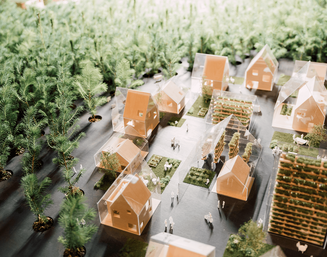Architecture Biennale 2021: a visit to the Arsenale
3 min readGrove
Philip Beesley & Living Architecture Systems Group / University of Waterloo School of Architecture
Grove is a gathering place created by soaring floating columns and cloud-like canopies. Lightweight digitally fabricated meshwork spires, spheres, and clouds are suspended from the ceiling. A vast array of speakers embedded within this forest form a 3D soundscape by Amsterdam-based collaborator Salvador Breed. Whispering sound and hovering ghostly emanations of movement and light are grouped around a central opening. A circular screen at the core reveals a film by London-based Warren du Preez and Nick Thornton Jones exploring worlds in formation. The Arsenale environment is twinned with another interactive environment entitled Meander, located in Cambridge, Canada. The film expands the space of Grove with a virtual exploration of Meander’s interwoven layers.
Material Culture: Rethinking The Physical Substrate For Living Together
Achim Menges / ICD University of Stuttgart and Jan Knippers / ITKE University of Stuttgart
The material substance of architecture provides the physical substrate on which we live together. Yet the materiality and materialization of buildings face severe challenges. Construction ranks among the human activities that consume materials the most and is significantly detrimental to the environment. At the same time, the United Nations predicts an increasing need for new buildings in the foreseeable future. Explorations into a new material culture in architecture are, therefore, necessary. Nature provides just such a paradigmatic alternative: almost all biological, load-bearing structures are made from fiber composites. Fibrous construction offers a profoundly different material approach for building human habitats in the future. Maison Fiber—the central component of this installation— is a radical model of a material future for architecture. Developed for this Biennale Architettura 2021, it is the first inhabitable, multistory, fibrous structure of its kind, made entirely from glass and carbon fiber composites. Each building element is individually tailored using a robotic fabrication process, resulting in a distinctive expression while using a minimal amount of material.
Interwoven
Leonmarcial arquitectos
This installation celebrates the interweaving of households and their environments using architectural means. This requires rethinking together our basic building blocks as drivers of change. Re-interpreting the lines of domestic private property which often restrict one’s notion of households leads to a transformation at the broader, public scale, one which allows for the construction of open structures that provide more equitable and dynamic living opportunities. Interwoven presents a spatial fragment focused on temporal transitions and interactions between households that dissolve outside-inside and public-private boundaries, where people interact and coexist.
![[Translate to englisch:] Arsenal - die Hauptausstellung der Architektur-Biennale [Translate to englisch:] Arsenal - die Hauptausstellung der Architektur-Biennale](/fileadmin/_processed_/b/5/csm_Arsenal_content_bb3f68bfb3.png)
![[Translate to englisch:] „Grove“ [Translate to englisch:] „Grove“](/fileadmin/_processed_/6/7/csm_Grove_content_e991f95264.png)
![[Translate to englisch:] „Grove“ [Translate to englisch:] „Grove“](/fileadmin/_processed_/0/6/csm_Grove_content_01_9ef86fd9c6.png)
![[Translate to englisch:] Arsenal - die Hauptausstellung der Architektur-Biennale [Translate to englisch:] Arsenal - die Hauptausstellung der Architektur-Biennale](/fileadmin/_processed_/e/1/csm_Material_Culture_content_4bc8b2529a.png)











